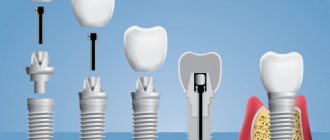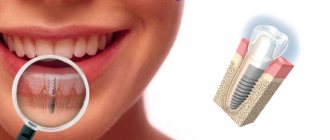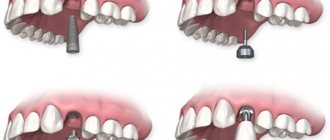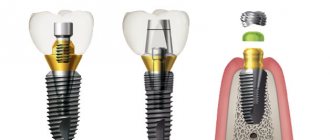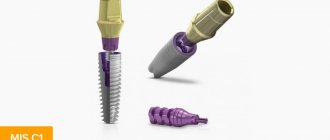In modern dentistry, there are many methods for restoring teeth. The choice of artificial material is huge, crown manufacturing technologies are improved every year.
The artificial structure is no different from real teeth.
In order to choose the right material, you should have the necessary information. Everything has certain properties, as well as a purpose.
Why can't we leave everything as it is?
When a person loses a tooth in the smile area, he usually tries to restore it - but with chewing teeth that are not visible, the situation is different. Many people think that if one chewing tooth is lost, then nothing bad has happened - the rest are in place, which means they can chew.
Each tooth in our jaw carries an important functional, and not just aesthetic, load. If the tooth is not restored, negative consequences will inevitably occur:
- improper distribution of the chewing load will lead to gradual destruction of the teeth next to the defect - after all, they will have to work for themselves and for the lost tooth;
- bone tissue atrophy will occur due to the fact that there is no load during chewing;
- Bite defects will appear - if a tooth has been missing for years, then its row neighbors gradually begin to shift towards the empty space;
- chewing food will not be of sufficient quality, which over the years will lead to the development of problems with the gastrointestinal tract;
- bite defects will negatively affect the functioning of the temporomandibular joint, which will provoke neck pain, headaches, discomfort and pain when opening the mouth or chewing, even insomnia;
- Diction problems will appear.
Is a compulsory medical insurance policy sufficient to obtain a quota?
The quota in orthopedic dentistry is the amount of qualified and high-tech medical care that a person can receive if he needs prosthetics. In this case, assistance is financed from the state budget. But not everyone can receive it, but only a person who meets certain criteria. Just having a compulsory medical insurance policy (compulsory health insurance) and a passport of a citizen of the Russian Federation is not enough here. Documents confirming social status, income or special contribution to the welfare of the state are also needed - the full list will be given below.
But how to place a tooth if there is no root?
The main goals of prosthetics are to return the patient to the ability to chew food normally, restore the aesthetics of a smile, and prevent further tooth decay due to chewing overload. Here are 3 main ways to insert a tooth:
- removable prosthetics
- making a prosthesis from nylon, acrylic, silicone, Acry Free material; - bridge prosthetics
- the classic technique involves grinding two adjacent teeth with a defect, which will be used as supports for a prosthesis that replaces a lost tooth. It is also possible to install a bridge on implants; - installation of an implant
followed by loading with a crown.
Sometimes patients ask if it is possible to grow a tooth in any way without a prosthesis? Alas, no - if a tooth is removed or lost along with the root, then there is literally nothing to build up. The methods of tooth extension, which we also talked about, are effective only in cases where there is a root and some volume of the crown has survived.
Composition of the “first” and “second” stages
The first stage includes the following categories of the population:
- Heroes and veterans of the Great Patriotic War,
- participants in military conflicts (servicemen of the army of the USSR or the Russian Federation),
- victims of repression,
- persons with disabilities,
- Heroes and Veterans of Labor.
“Those categories of citizens for whom dentures are vitally necessary can bypass the queue for free prosthetics under the Federal or regional program and get to the beginning. This includes patients with oncological pathologies, serious injuries to the jaw system, as well as those who have undergone surgery on the gastrointestinal tract. You just need to get a certificate from your doctor."
Complex on 4 OSSTEM implants with delayed loading - from RUB 170,000.
Complex implantation Osstem (South Korea) with delayed loading after 4-6 months.
Guarantee for the doctor’s work - unlimited Call now or order a call
Opening hours: 24 hours a day - seven days a week
The second group includes the following groups of citizens:
- non-working pensioners who have no additional income other than a pension,
- persons whose average per capita income is less than half the subsistence level in the region,
- liquidators and disabled people of the Chernobyl accident.
Read more about what kind of prosthetics is suitable for pensioners and how to get it for free.
Removable dentures
For centuries, dentists have been solving the problem: if there is no root, how to make a tooth? The first option, which has been around for thousands of years, is removable dentures. They were found during excavations of Egyptian tombs and in the territory of the Mayan Indians, so this is one of the most ancient methods of restoring teeth.
What are its advantages? Firstly, it is fast - making a prosthesis takes from 3 to 7 days, depending on the complexity of the work; secondly, it is inexpensive compared to bridges or implants. Modern materials for removable dentures make it possible to create structures similar to natural teeth, but they still have disadvantages:
- service life even with careful care is about 5–7 years;
- constant risk of prosthesis falling out and the need for additional fixation;
- the prosthesis does not stop bone atrophy;
- does not allow the chewing load to be evenly distributed;
- sometimes causes diction defects;
- there is a risk of allergies to acrylic, nylon, silicone and other materials.
Removable prosthetics are now being used if there are absolute contraindications to the installation of bridges or implants, or as a temporary measure while the patient waits for a permanent prosthesis to be made.
Who can use the quota
Who is entitled to a quota for dental prosthetics? It can be received by socially vulnerable segments of the population - pensioners, disabled people, disabled children, people with severe pathologies. The list should also be supplemented by pensioners of the Ministry of Internal Affairs and those who retired from military service, heroes of the Second World War, home front workers, Heroes and Veterans of Labor, Heroes of the USSR and the Russian Federation, mothers of many children, etc.
You need to know that there are several programs for free dental prosthetics - federal and regional. The federal list includes only those pensioners who retired from government, military service and the Ministry of Internal Affairs. Regions or subjects of the Russian Federation supplement this list with other categories of citizens. You can use the quota for free prosthetics once every 5 years.
Bridges
The good old classic that dentists offer when they see that a root is missing. Bridges do not need to be removed from your mouth every day to be cleaned, unlike removable dentures, they will last 10-12 years with proper care and are much better at restoring chewing function. Modern materials are quite effective at restoring a beautiful appearance to a smile. The price and production time of such a prosthesis is higher than that of a removable prosthesis, but lower than that of an implant.
What are the disadvantages of this technique?
- With classic prosthetics relying on your own teeth, due to the uneven distribution of the load during chewing, the supporting teeth under the bridge gradually begin to collapse.
- Bone atrophy also does not stop.
- The denture requires special cleaning products - pipe cleaners, brushes, etc., otherwise food debris and plaque will accumulate under it.
- The implant-based method is not always possible - if one tooth or two in a row is lost, the doctor will not remove adjacent healthy teeth in order to put implants in their place.
Indications for removal along with the root
No dentist will remove a tooth just like that, since each one is important for the normal functioning of the dental system - doctors still try to preserve them. To do this, fillings or restorative inlays, crowns, pins and stump inlays are placed in the root canals. So is it necessary to remove tooth roots before getting dentures? Yes, indeed, sometimes situations arise that removal is the only option, otherwise complications are possible - up to infection of the jaw bone or loss of all units in a row.
Let's consider cases when deletion is indispensable:
- the presence of vertical cracks in the roots,
- irreparable perforations in the root wall or in the bifurcation area (the place where the roots begin to branch under the crown),
- presence of a piece of dental instrument in the root canal that cannot be removed,
- chipping of the crown deep under the gum: in this case, placing a filling or core inlay may be problematic due to the damp environment around - such a restoration will not last long,
- the presence of neoplasms under the roots (cysts, granulomas) that cannot be eliminated without removal,
- destruction or complete dislocation due to injury: blow, bruise, gnawing something hard,
- inability to go through root canals with an instrument due to their non-standard shape,
- osteomyelitis of the jaw: if osteotomy (cutting off) of pathological areas of the bone is required,
- severe loss of bone and gums against the background of the late stages of periodontitis and periodontal disease: here the teeth become very mobile, and tartar builds up along the roots - an infectious focus arises, which leads to inflammation and toxic damage to the surrounding tissues (gums and jaw bone).
Dental implantation
A provocative question: is it possible to put a crown on the root of a tooth? Yes, if this root is an artificial implant made of titanium alloy or even zirconium. Installing an implant solves almost all problems with tooth loss:
- stops bone atrophy;
- completely restores the natural distribution of chewing load;
- no damage to neighboring teeth;
- excellent aesthetic result;
- implant service life - from 25–30 years to lifelong;
- a large number of possible options for creating crowns - ceramics, metal-ceramics, solid zirconium or zirconium with ceramic lining;
- ease of care, no different from the hygiene of natural teeth.
Prosthetics with zirconium crowns –
The next option for aesthetic prosthetics of the front teeth is ceramic crowns made of zirconium dioxide (such crowns are called zirconium). This material has the strength of metal, and therefore crowns made from it do not require an internal metal frame. The absence of the latter should certainly provide more aesthetic options when using prosthetics with zirconium crowns, but in reality, not everything is so simple, and you can find a huge number of patients who are dissatisfied with such prosthetics.
Let's start with the fact that there are 2 types of zirconium crowns.
- The first option assumes that only the internal frame reinforcing the structure is milled from zirconium dioxide, which will then be covered with layers of ceramic mass (porcelain). The disadvantage of this option is that the porcelain often chips. According to statistics, after 3 years, chips occur in at least 6% of patients with zirconium crowns, and after 5 years – in at least 10% of patients.
In addition, if for this version of crowns a cheap version of zirconium dioxide blocks is used (milky white, not transparent, i.e. translucent), then even after applying layers of porcelain, the crowns end up looking unnatural, because have a milky tint.Clinical case No. 4 –
Note the unnatural color (no color gradient from the neck of the tooth towards the incisal edge of the incisors) that is present on adjacent teeth. In addition, there is no transparency of the cutting edges, i.e. crowns essentially look like plastic. Keep in mind that in most clinics in our country, zirconium crowns are made at approximately this low professional level.
- The second option is monolithic zirconium crowns “Multi-layer”. Monolithic - means that the crowns will be made entirely of zirconium dioxide, i.e. without applying layers of porcelain (accordingly, in this case there is no problem of ceramic chipping). But the most important thing is that in this case more expensive “Multi-layer” zirconium dioxide blocks will be used.
Such blocks have a gradient of color and transparency, which makes it possible to mill crowns from them, which will also have a gradient of color and transparency, varying from the neck of the tooth and towards the incisal edge. Accordingly, the presence of a gradient of color and translucency will make the crowns on the front teeth more similar to real ones.Clinical case No. 5 (multi-layer) –
In the photo above you can see newly made “Multi-layer” zirconium crowns, which still need to be fixed in the oral cavity. The crowns are made for the entire dentition - they are single crowns, with the exception of a 3-unit zirconia bridge in the side of the jaw (where you can see the artificial pink gum). Pay attention to the natural color and transparency that change - in the direction from the necks of the crowns to the cutting edge.
Is it worth it or not to make zirconium crowns?
Everything will depend on the specific situation in the oral cavity. In general, zirconium dioxide crowns are a good choice if you need to replace an entire group of front teeth at once (for example, 6-8 or more). This is because the dental technician only has a limited range of color options when working with zirconia. Those. If you have a complex tooth color, then one or more crowns will almost always differ from your neighboring natural teeth.
But this problem is solved if you do all the front teeth at once, in which case they will all look the same. And in this case, of course, you should pay attention to the fact that the crowns are made monolithic - from “Multi-layer” zirconium dioxide blocks, and not from cheap milky-white blocks that are not translucent. BUT, again, sometimes you have to deviate from this rule if the patient only needs 1-2 single crowns on the front teeth.
In this case, only the frame is milled from “Multi-layer” zirconium dioxide blocks, and then layers of porcelain are applied to it. Despite the higher risk of chipping, this technology will allow the dental technician to make crowns more similar to neighboring teeth, because When working with porcelain, the dental technician has a much wider range of color options. The main thing here is that cheap milky-white zirconium dioxide, which does not have translucency, is not used for the frame of the crowns.
The cost of zirconium crowns - the cost of 1 zirconium crown averages from 30,000 to 40,000 rubles. In the regions you can find prices starting from 25,000 rubles, but for this price the crowns will be made of cheap zirconium dioxide of a milky white color, which is not translucent. At the same time, we will next tell you about Emax ceramic crowns, the price of which averages from 25,000 to 30,000 rubles, and this despite the fact that they also benefit in aesthetics.
Zirconium dioxide with increased aesthetics:
Clinical case No. 6 –
Clinical case No. 7 –
When choosing ceramic zirconium crowns for your front teeth, you must ask your doctor for information about the manufacturer of the zirconium dioxide blocks from which your crowns will be milled. These should be translucent/pre-colored zirconium dioxide blocks (“multi-layer”) - preferably such as Katana® UTML (Japan) or Prettau® Anterior (Germany).
For more information about the various options for manufacturing zirconium crowns, read the article: → Options for manufacturing zirconium crowns, prices"
What to choose?
What to install if there is no root - a removable denture, a bridge or an implant? The dentist will select prosthetic options based on the condition of the oral cavity and the presence of relative or absolute contraindications. However, today doctors most often offer implant prosthetics. It has only two disadvantages compared to other types - a higher price and a longer period of prosthetics with several stages. However, this is compensated by excellent, long-term and predictable results. In addition, implantation technologies are constantly being improved; there are already techniques and implants that can significantly reduce the time of prosthetics.
Where to go and how long to wait for your turn
How to get a quota for dental prosthetics? You should first contact your local Social Security Administration office or Department of Health. In small settlements - to the village administration. If a pensioner worked at an enterprise that had a good voluntary medical insurance program - additional health insurance, then you should contact the personnel department or trade union committee. Take with you your passport and pension certificate, work record book, and a doctor’s note about a previous (current) serious illness. This way it will be clear whether you can count on the quota or not.
Then you definitely need to visit a dentist - specifically in a public clinic, and get a certificate from a doctor that dentures are really necessary. This certificate, along with a package of documents, is submitted to social security, where the application is written. Then, within 10 days, a special commission considers it. Next comes queuing - the average waiting period is 3-6 months, but sometimes people wait 1.5-2 years or more for their turn. When the turn comes, the person is informed about it. You need to come to the social security office again to get a coupon (referral).
Be careful, in different regions the validity period of the referral ranges from 14 days to 3-6 months. And if you take it to the dentist later, it will no longer be valid - you will have to collect documents again and stand in line.
At the clinic, an agreement is concluded with the patient (this is a mandatory stage), which prescribes future treatment, prosthetics, a warranty period (usually 12 months), and the responsibility of the parties. For example, it is possible to repair a prosthesis free of charge under warranty during the first year of operation only if the person handled it with care and did not initiate the breakdown. After official registration, dental prosthetics begins.
